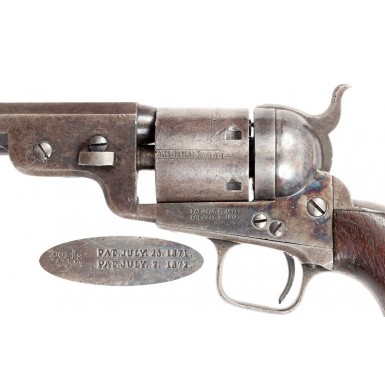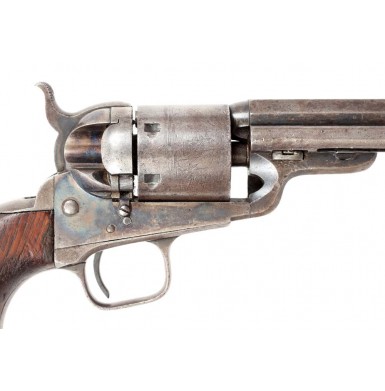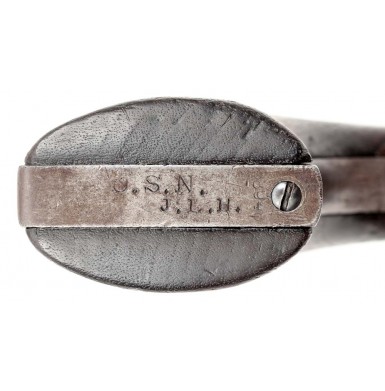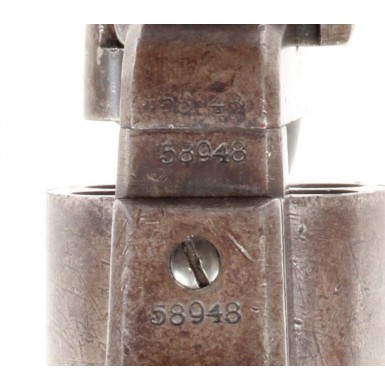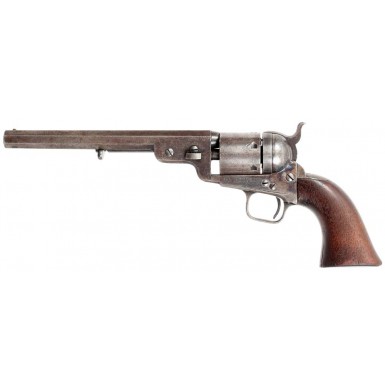Colt M-1851 Navy-Navy Richards-Mason Conversion
- Product Code: FHG-1727-SOLD
- Availability: Out Of Stock
-
$1.00
The mid-1850s was a revolutionary time for small arms development around the world, and the United States was no exception. The US Army had already adopted the percussion revolver in limited numbers for the US Mounted Rifles and US Dragoons by acquiring Colt “Dragoon”, .44 caliber “holster” (as in pommel holster) revolvers in 1848. The US Navy, however, remained steadfast in their belief single shot, muzzle-loading pistols were sufficient for the use of their seamen. In 1851 Colt introduced his “belt revolver”, a slimmed down, lighter weight, 6-shot .36 caliber handgun that would become known by its year of introduction as the M-1851 revolver, or simply by it’s nickname, the Colt “Navy” revolver. The number of Colt’s .36 caliber M-1851 “Navy” revolvers purchased by the US Navy was rather limited. While Colt had vigorously lobbied the Navy to purchase his revolving pistols during the early 1850’s, he met with significant resistance. He did manage to secure an order for 100 revolvers in June of 1852 for the use of Commander Perry’s command on his voyage to Japan. However, the general belief of the Naval Ordnance Department was that pistols were only of use while boarding an enemy ship, and in those circumstances edged weapons such as sabers or axes were of more use to the typical seaman. In fact the chief of Naval Ordnance, Commodore Morris wrote to Secretary of the Navy James Dobbin on June 21, 1854, noting in part:
“It has not been considered advisable heretofore, to purchase Colts revolvers for general service”.Pistols can seldom be used with effect in the Navy, except when boarding vessels, with the view to their capture, which very rarely occurs. At such time, the contest soon becomes hand to hand when sword or boarding hatchets could be used by seamen, with equal, if not greater certainty and effect than pistols.”
Colt was not to be discouraged, and ever the consummate salesman, he did manage to sell the Navy 50 of his M-1851 revolvers in June of 1856 and an additional 50 revolvers in May of 1857. In September of that year, the Navy finally placed a large order for M-1851 revolvers. They purchased 2,000 (less the ones that had been previously ordered), which were delivered starting in November of 1857. These guns appear in the 55500 to 62000 serial number range. The first 615 were delivered for inspection at the Norfolk Naval Yard on November 9, 1857. The next batch of 667 were delivered to the Boston Naval Yard on December 6, and rest of the guns were delivered to the New York Navy Yard later that same month. The Navy placed a second order for an additional 600 M-1851s in August of 1859. These guns were in the 89000 to 91000 serial number range, with half of the guns delivered to the New York Naval Yard and the other half delivered to the Boston Naval Yard. The USN purchased Cot M-1851 revolvers were unique in that they were specifically ordered with iron backstraps and triggerguards. This is particularly interesting because the standard production revolvers had brass backstraps and triggerguards, which were less likely to be damaged by the corrosive salt air environment the revolvers would be exposed to in service. By 1860, Colt M-1851 revolvers were listed in the small arms inventories of nearly 30 US Naval vessels, including the USS Caledonia, USS Colorado, USS Congress, USS Crusader, USS Cumberland, USS Decatur, USS Fennimore Cooper, USS Fulton, USS Independence, USS John Adams, USS Lancaster, USS Merrimack, USS Mississippi, USS Pawnee, USS Plymouth, USS Porpoise, USS Powhatan, USS Portsmouth, USS Roanoke, USS Sabine, USS Saranac, USS Saratoga, USS St. Mary’s, USS Susquehanna, USS Vincennes, USS Wabash, USS Water Witch & USS Westernport. The end of the Civil War essentially announced the end of the percussion firearms era for the US military. The effectiveness and reliability of self-contained metallic cartridges had been more than proven on the battlefield; all of the US armed forces were looking for ways to modernize their small arms by adopting cartridge-firing weapons. Even the incredibly traditional US Navy looked for a self-contained cartridge handgun to add to their small arms inventory. However, the traditional attitude about the utility of pistols remained in place at the top echelon of the Naval hierarchy during the first decade of the post-Civil War years. As a result, the Navy adopted the Remington rolling block single-shot pistol as their standard sidearm in 1865. This clearly indicated the Navy felt that self-contained cartridges were desirable for pistols, but the multi-shot firepower of a revolver was not! The Navy was also caught in a budget crisis that arose from government debt that was accrued during the Civil War, and from an over abundance of small arms, albeit obsolete, on hand. The reality was there was simply no budget to widespread acquisition of cartridge revolvers, nor was there a general consensus regarding which revolver might be the appropriate choice. In 1873 the Colt Patent Firearms Company approached the Navy with a potential solution that was low cost and allowed the Navy to upgrade many of their obsolete percussion revolvers to cartridge handguns. General W.B. Franklin, Vice President of Colt, offered to upgrade existing stocks of M-1851 and M-1861 Navy revolvers to centerfire cartridge via the Richards-Mason conversion system for $3.50 each. In a July 10, 1873 letter to Franklin, USN Chief of Ordnance William N. Jeffers accepted the offer from Colt and noted that he had “advised the Commandant(s) of the Boston, New York and Philadelphia Navy Yards to send to your manufactory 100, 400 and 300 pistols respectively for alteration.”. Thus began the process by which some 2,097 US Navy owned .36 caliber Colt percussion revolvers were altered to metallic cartridge by the Richards-Mason system. The guns were all altered to .38 Long Colt, and while some sources suggest the barrels were reamed and re-rifled, the reality is that the bores of the guns were not altered, although a few barrels were replaced by Colt due to the poor condition of the bores. The alteration consisted of a series of modifications to the frame, cylinder and barrel of the revolver. The cylinder was modified by milling down a portion of its rear, removing the percussion cones (nipples) and creating a bored-through chamber, while leaving the original ratchet mechanism in tact. The chambers were then reamed out to accept the .38 Long Colt cartridge cases. A conversion breech plate was added to the frame, mounted in front of the original recoil shield and loading gate was added on the right side of the frame. A new, longer, 2-pronged hand was added to the internal mechanism to actuate the cylinder and the ratchet on the rear of the cylinder were re-cut to insure proper timing and indexing. The barrel had the loading lever and associated catch removed, and dovetail for the catch, as well as the loading lever mounting recess were both filled. The hole in the front of the frame through which the rammer plunger passed was not modified. A Mason pattern ejector rod assembly was added to the right side of the barrel, consisting of an ejector rod tube, with a spring loaded ejector rod that was tipped with a kidney shaped plunger tip with concentric rings embossed on the front to insure a good grip while using the ejector rod. After the alteration the pistols were refinished by Colt. At least one letter from Colt to Navy suggested that the iron backstraps of the M-1851 Navy revolvers be polished and refinished, and new grips be installed on the revolvers to improve their overall appearance and bring them up to the standards of the rest of the gun that had been refinished after the alteration process. The Navy agreed and paid Colt an additional $0.75 for each gun that had the backstrap refinished and the grips replaced. The poor condition of the iron backstraps was specifically noted, and again begs the question of why the Navy insisted on iron instead of the standard brass for their revolver backstraps. As a result of the replacement of most of the grips on the guns sent to Colt, original USN inspection marks in the grips are usually missing from the cartridge converted “Navy-Navy” revolvers. Due to the polishing and refinishing, the original percussion era marks on the guns are often weak or missing, as are most of the original Naval markings in the metal. The pistols were stamped on the lower left side of the frame with the two-line patent date legend that referenced both the Richards and the Mason patents. In almost all cases the wedges of the cartridge-altered revolvers were replaced with new Colt factory wedges (both left over percussion wedges with springs and cartridge wedges without springs), all of which were unnumbered. For some reason, a large number of the M-1851 Navy-Navy revolvers that were altered ended up with mismatched cylinders that were typically renumbered to match the gun, either below the original serial number on the side of the cylinder or on the rear face of the cylinder. It is generally believed that only a maximum of 1,000 of the Colt Navy-Navy cartridge conversions were performed on M-1851 Navy revolvers, with the balance performed on M-1861 Navy revolvers. When the revolvers were returned to the various Navy yards from Colt, only those sent to the New York Navy Yard received any inspection marks. The revolvers sent to New York were inspected by Commander Richard W. Meade, who stamped his initials and an anchor under the barrels, forward of the frame. Those pistols with the R.W.M. (ANCHOR) mark can be concretely attributed to having been inspected at the New York Navy Yard after alteration. No known inspection markings have been attributed to the revolvers returned to the Boston, Philadelphia, Norfolk and Portsmouth Navy Yards. Today all of the Richards-Mason converted Colt Navy-Navy revolvers are scarce, with less than 100 of the 1,000 altered guns believed to remain in existence. The revolver is an important one in any martial collection as it is the first metallic cartridge revolver used by the US Navy and one of the first metallic cartridge revolvers used by any of the US armed forces.
This Richards-Mason Converted Colt M-1851 Navy-Navy revolver is part of the original order for 2,000 guns and was one of the very first gun delivered, arriving with 614 other “navies’ at the Norfolk Naval Yard on November 9, 1857. There they were inspected by Commander James L. Henderson, who inspected small arms at Norfolk from June of 1857 through April of 1861. Henderson’s J.L.H. inspection mark is clearly stamped in the bottom of the iron grip strap, along with the initials U.S.N.. Henderson was the only USN inspector to put his mark in the metal of the gun, with all other inspectors marking the bottoms of the grips. As the grips were usually replaced during the alteration to cartridge at the Colt factory, it is difficult to determine where those guns were originally delivered. In this case, we know for certain which shipment of arms, and to which naval facility the revolver was originally delivered in 1857. The revolver is serial number 58948, which places it in late 1856 production. The serial number is found on all major components, with the exception of the cylinder (which will be discussed below) and the unmarked wedge, which was replaced by Colt during the alteration process. Like all of the Colt M-1851s delivered under the 1st USN contract, the revolver has a London style iron backstrap and a large London style iron triggerguard with a “squared off”, “flat bottom” profile. The lower front portion of the left side of the frame is marked in three lines: COLT’s / PATENT / U. S., and amazingly the markings are all still quite legible, even after the Colt refinishing of the frame. Only the “US’ is somewhat weak. The left side of the frame is additionally marked in two lines: PAT. JULY. 23, 1871. / PAT. JYLY. 2, 1872. The octagon barrel is marked with the early production New York barrel address that reads: “ ADDRESS SAML COLT NEW - YORK CITY”. The cylinder is marked with the usual COLT’s PATENT No 941” and with the typical naval engagement scene which remains about 75%+ visible. Even the ENGAGED 16 MAY 1843 remains mostly legible. As with many of the Colt Navy-Navy revolvers that were converted by Colt, the cylinder is mismatched, and the last four digits of the number on the side of the cylinder read 941”, and not 8948 as it would if it matched. These cylinders were sometimes re-numbered below the original number on the side of the cylinder and were sometimes numbered with the last 3 digits of the serial number on the rear face of the cylinder. This one is numbered on the rear face, but the numbers are 208 and 948. This could represent a factory mistake, but more likely it suggests the cylinder was swapped in the field while in service with the Navy during the 1870s and 1880s. The rear face of the cylinder also bears a single H inspection mark. The bottom of the barrel is not stamped with the R.W.M. (ANCHOR) inspection mark, so we know the gun was not sent to the New York Navy Yard after it was converted by Colt, but it could have gone to any number of other US Navy installations. An August 12, 1873 letter from Commander Jeffers to Colt asked that when the first 100 revolvers were altered that 50 be sent to the New York Navy Yard and 50 to Portsmouth. No doubt Colt delivered the guns to the various navy yards as needed, and at Jeffers’ direction. The gun is in VERY GOOD+ to NEAR FINE condition and remains very crisp and sharp throughout, with good edges and clear markings. The pistol retains about 10% of its original Colt factory blued finish on the barrel, mostly in protected areas around the barrel web, and along the edges of the ejector housing. The balance of the barrel retains minor traces of blue that has blended with a smooth plum brown and gray patina over the balance of the barrel. The frame retains about 70%+ of the vivid Colt case hardened finish, with the balance of the frame dulling and fading to a pewter gray patina. The hammer retains about 75%+ of its vivid Colt case hardened finish as well. The metal surfaces are mostly smooth, with some scattered patches of light pinpricking, mostly on the barrel. There are also some areas of light surface oxidation around the muzzle, and scattered on the barrel. The cylinder retains about 75%+ of the roll engraved Mexican War naval battle scene, and has a medium plum-brown patina mixed with some minor traces of finish, over a pewter base metal color. The loading gate retains much of its original case hardened finish and is numbered 625, matching it to the Type III Richards conversion ring at the rear of the cylinder. The ring is numbered on its back, but the cylinder arbor must be removed to remove the ring and check the number. It certainly matches the loading gate. These parts were assembly numbered together during the manufacturing process and were never numbered to the guns that they were installed in. The gate uses the less common “outside” spring to secure it, and the spring retains about 50% of its original niter blued finish. The gate functions smoothly and correctly. The action of the pistol is EXCELLENT and the revolver remains tight, timing and indexing perfectly and locking up as it should. The trigger retains bout 30% of its original niter blued finish and functions crisply as well. The iron backstrap and triggerguard also retain traces of their original Colt blue, mixed with a smooth plum-brown patina. The ejector rod housing retains about 10% of its original blue, most of which is in the protected nooks and crannies where it mates with the barrel. The ejector rod button is of the correct kidney shaped pattern with the concentric rings, and retains about 30% of its niter-blued finish. The ejector rod functions smoothly and correctly as well. The gun appears to retain all of its original screws as well, which are in very nice condition and show minimal slot wear. The screws all retain strong traces of their niter-blued finish, although they have faded and dulled with age. The bore of the pistol rates about FINE, and remains relatively bright with crisp rifling and only some lightly scattered pitting along its length. The one-piece, oil finished, black walnut grips are in VERY GOOD+ condition, and are free of any breaks, cracks or repairs. The grips do show some the expected bumps, dings and handling marks from use and service. The grips are unnumbered and were almost certainly replaced by Colt during the alteration. They fit the gripstrap and frame perfectly and show wear commensurate with the balance of the revolver. The grips show a couple of minor chips, both at the leading edges of the bottom front of the grip frame. This is minor, but mentioned for exactness, and in no way affects the display of this rare pistol.
Overall this is a really lovely, 100% original complete and correct Colt M-1851 Richards-Mason Converted Navy-Navy. These are very scarce guns, with only about 1,000 so altered. While the cylinder is mismatched, it is also from a Navy-Navy alteration and is correct. The patina makes it clear the gun and cylinder have been together since the period of use. This gun has a really wonderful look and has not been messed with in any way. It is in much better condition than most Navy purchased M-1851 conversions encountered, and it would be hard to imagine finding a conversion with crisper and clearer inspector markings from its percussion service. This is one of those guns that had a service life of well over 3 decades, serving the navy in the years leading up to the Civil War, during the war and then being converted in 1873 to serve another decade or more until the M-1889 Colt Navy double action revolver was taken into service. With all of that service and use it is amazing the gun is as crisp as it is. A Colt Navy-Navy is a real coup for any serious collector of US marital revolvers to acquire, and a Richards-Mason conversion is even harder to find. This gun would be a great addition to any such collection or to a Civil War or USN collection. This is simply a great gun that you will be very proud to own and to display.
SOLDTags: Colt, M, 1851, Navy, Navy, Richards, Mason, Conversion


